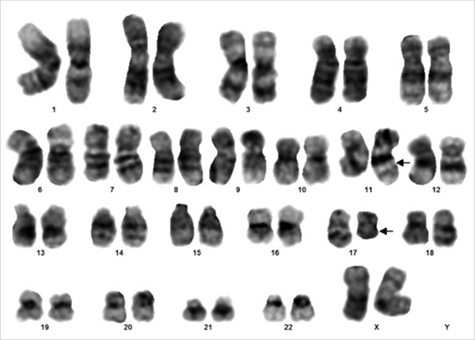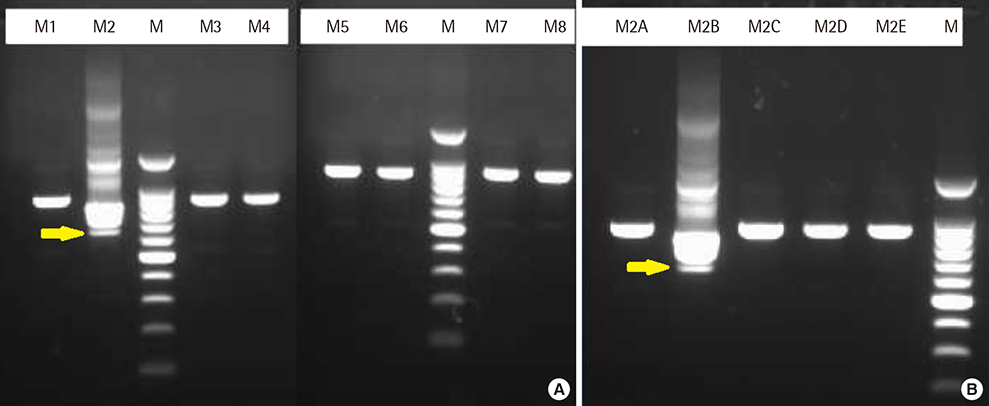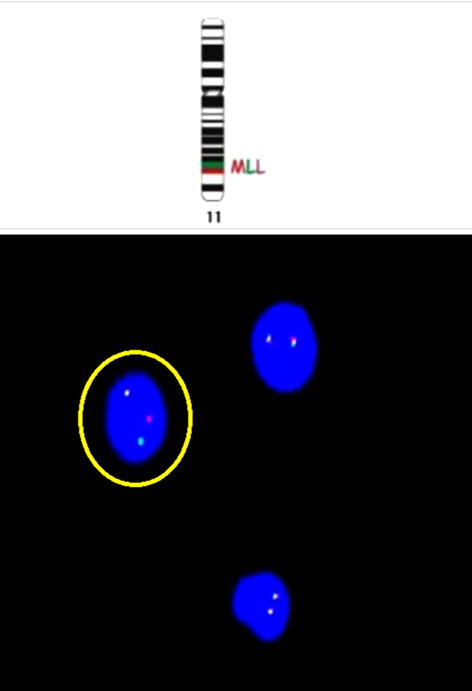Lab Med Online.
2019 Oct;9(4):258-262. 10.3343/lmo.2019.9.4.258.
Acute Monoblastic Leukemia with t(11;17)(q23;q21): Fusion of the KMT2A(MLL) and MLLT6(AF17) Genes
- Affiliations
-
- 1Department of Laboratory Medicine, Daegu Catholic University School of Medicine, Daegu, Korea. sgkim@cu.ac.kr
- KMID: 2458689
- DOI: http://doi.org/10.3343/lmo.2019.9.4.258
Abstract
- The KMT2A (formerly MLL) gene is associated with at least 10% of all cases of acute leukemia. More than 80 translocation partner genes of KMT2A have been discovered to date, six of which have been identified on the long arm of chromosome 17. Among these, the MLLT6 (formerly AF17) gene is located at 17q12 and fuses with the KMT2A gene in rare cases of acute leukemia. We report here a case of AML with a KMT2A/MLLT6 fusion that was confirmed using molecular genetic methods. According to a literature review, this is the first reported case of AML with a KMT2A/MLLT6 fusion in Korea.
Keyword
Figure
Reference
-
1. Huret JL. MLL (myeloid/lymphoid or mixed lineage leukemia). Atlas Genet Cytogenet Oncol Haematol. 2006; 10:83–87.
Article2. Burillo-Sanz S, Morales-Camacho RM, Caballero-Velázquez T, Carrillo E, Sánchez J, Pérez-López O, et al. MLL-rearranged acute myeloid leukemia: Influence of the genetic partner in allo-HSCT response and prognostic factor of MLL 3′ region mRNA expression. Eur J Haematol. 2018; 100:436–443.
Article3. Deqing Hu. Epigenetics of hematopoiesis and hematological malignancies. Genes Dev. 2016; 30:2021–2041.
Article4. Bennett JM, Catovsky D, Daniel MT, Flandrin G, Galton DA, Gralnick HR, et al. Proposed revised criteria for the classification of acute myeloid leukemia. A report of the French-American-British Cooperative Group. Ann Intern Med. 1985; 103:620–625.
Article5. Schoch C, Schnittger S, Klaus M, Kern W, Hiddemann W, Haferlach T. AML with 11q23/MLL abnormalities as defined by the WHO classification: incidence, partner chromosomes, FAB subtype, age distribution, and prognostic impact in an unselected series of 1897 cytogenetically analyzed AML cases. Blood. 2003; 102:2395–2402.
Article6. Huret JL. AF17 (ALL1 fused gene from chromosome 17). Atlas Genet Cytogenet Oncol Haematol. 1997; 1:53.
Article7. Meyer C, Hofmann J, Burmeister T, Gröger D, Park TS, Emerenciano M, et al. The MLL recombinome of acute leukemias in 2013. Leukemia. 2013; 27:2165–2176.8. Prasad R, Leshkowitz D, Gu Y, Alder H, Nakamura T, Saito H, et al. Leucine-zipper dimerization motif encoded by the AF17 gene fused to ALL-1 (MLL) in acute leukemia. Proc Natl Acad Sci USA. 1994; 91:8107–8111.
Article9. Suzukawa K, Shimizu S, Nemoto N, Takei N, Taki T, Nagasawa T. Identification of a chromosomal breakpoint and detection of a novel form of an MLL-AF17 fusion transcript in acute monocytic leukemia with t(11;17)(q23;q21). Int J Hematol. 2005; 82:38–41.
Article10. Moore SD, Strehl S, Dal Cin P. Acute myelocytic leukemia with t(11;17)(q23;q12-q21) involves a fusion of MLL and AF17. Cancer Genet Cytogenet. 2005; 157:87–89.
Article11. Strehl S, König M, Meyer C, Schneider B, Harbott J, Jäger U, et al. Molecular dissection of t(11;17) in acute myeloid leukemia reveals a variety of gene fusions with heterogeneous fusion transcripts and multiple splice variants. Genes Chromosomes Cancer. 2006; 45:1041–1049.
Article12. Grossmann V, Kohlmann A, Klein HU, Schindela S, Schnittger S, Dicker F, et al. Targeted next-generation sequencing detects point mutations, insertions, deletions and balanced chromosomal rearrangements as well as identifies novel leukemia-specific fusion genes in a single procedure. Leukemia. 2011; 25:671–680.
Article13. De Braekeleer E, Meyer C, Douet-Guilbert N, Basinko A, Le Bris MJ, Morel F, et al. Identification of MLL partner genes in 27 patients with acute leukemia from a single cytogenetic laboratory. Mol Oncol. 2011; 5:555–563.
Article14. ThermoFisher Scientific. Oncomine myeloid research assay. last visited on Jan 2019. https://www.thermofisher.com/kr/ko/home/clinical/preclinical-companion-diagnostic-development/oncomine-oncology/oncomine-myeloid-research-assay.html.15. Ma S, Huang Y, van Huystee RB. Improved plant RNA stability in storage. Anal Biochem. 2004; 326:122–124.
Article16. Kim KE, Kim SH, Han JY. Acute monocytic leukemia with t(11;17)(q23;q21) involving a rearrangement of mixed lineage leukemia gene. Korean J Lab Med. 2006; 26:329–333.
Article17. Reeves BR, Kempski H, Jani K, Borrow J, Howe K, Solomon E, et al. A case of acute monocytic leukemia with t(11;17) involving a rearrangement of MLL-1 and a region proximal to the RARA gene. Cancer Genet Cytogenet. 1994; 74:50–53.
Article18. Douet-Guilbert N, Morel F, Le Bris MJ, Herry A, Morice P, Bourquard P, et al. Rearrangement of the MLL gene in acute myeloblastic leukemia: report of two rare translocations. Cancer Genet Cytogenet. 2005; 157:169–174.
Article19. Swerdlow SH, Campo E, editors. WHO classification of tumours of haematopoietic and lymphoid tissues. Revised 4th ed. Lyon, France: IARC;2017.20. King RL, Naghashpour M, Watt CD, Morrissette JJ, Bagg A. A comparative analysis of molecular genetic and conventional cytogenetic detection of diagnostically important translocations in more than 400 cases of acute leukemia, highlighting the frequency of false-negative conventional cytogenetics. Am J Clin Pathol. 2011; 135:921–928.
Article
- Full Text Links
- Actions
-
Cited
- CITED
-
- Close
- Share
- Similar articles
-
- Acute Monocytic Leukemia with t(11;17)(q23;q21) Involving a Rearrangement of Mixed Lineage Leukemia Gene
- Rapid Detection of Prognostically Significant Fusion Transcripts in Acute Leukemia Using Simplified Multiplex Reverse Transcription Polymerase Chain Reaction
- ZBTB16-RARalpha variant of acute promyelocytic leukemia with tuberculosis: a case report and review of literature
- Systematic Classification of Mixed-Lineage Leukemia Fusion Partners Predicts Additional Cancer Pathways
- Three-way Translocation of MLL/MLLT3, t(1;9;11)(p34.2;p22;q23), in a Pediatric Case of Acute Myeloid Leukemia





